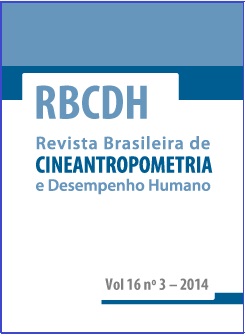Lower limb joint alignment and postural control in elderly women
DOI:
https://doi.org/10.1590/1980-0037.2014v16n3p287Resumen
The aim of this study was to test whether quiet stance body sway is associated with ankle and knee joint angles in elderly women. Joint angles were measured using a manual goniometer and body sway was assessed using a force platform and four postural tasks with a combination of feet positions and eye condition. The sample (N = 58) showed the following angle values: 102 (100-104) for the tibiotarsal joint, 176 (174-180) for the subtalar joint, 184 (181-187) for knee flexion-extension, and 13 (10-15) for the Q-angle. Q-angle was significantly correlated (p < 0.05) with center of foot pressure (CP) displacement area (r = 0.36), anteroposterior (SDy, r = 0.34) and lateral (SDx, r = 0.31) CP standard deviation, and anteroposterior CP range (r = 0.38) during the closed base, eyes opened trial (CBEO). The valgus group showed statistically higher values than the normal and varus groups for SDy (0.56 vs. 0.52 and 0.46 mm; p = 0.02), SDx (0.55 vs. 0.49 and 0.36 mm; p = 0.02) and anteroposterior range (3.32 vs. 2.78 and 2.38 mm; p = 0.01), CBEO. The displacement velocity of the CP was significantly higher for the asymmetric than the symmetric Q-angle group (8.0 vs. 5.3 mm/s – closed base, eyes closed trial). Knee alignment was correlated with measures of body sway in elderly women, but ankle alignment showed no correlation. Knee morphology should be considered an associated factor for quiet stance postural control.
Descargas
Publicado
Número
Sección
Licencia

Direitos Autorais para artigos publicados nesta revista são do autor, com direitos de primeira publicação para a revista. Em virtude da aparecerem nesta revista de acesso público, os artigos são de uso gratuito, com atribuições próprias, em aplicações educacionais e não-comerciais, desde que seja dada a atribuição. Esta obra foi licenciada com uma Licença Creative Commons Atribuição 4.0 Internacional - CC BY


